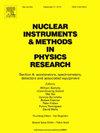Implementation of light diagnostics for wakefields at AWAKE
IF 1.5
3区 物理与天体物理
Q3 INSTRUMENTS & INSTRUMENTATION
Nuclear Instruments & Methods in Physics Research Section A-accelerators Spectrometers Detectors and Associated Equipment
Pub Date : 2025-03-21
DOI:10.1016/j.nima.2025.170426
引用次数: 0
Abstract
We describe the implementation of light diagnostics for studying the self-modulation instability of a long relativistic proton bunch in a 10 m-long plasma. The wakefields driven by the proton bunch dissipate their energy in the surrounding plasma. The amount of light emitted as atomic line radiation is related to the amount of energy dissipated in the plasma. We describe the setup and calibration of the light diagnostics, configured for a discharge plasma source and a vapor plasma source. For both sources, we analyze measurements of the light from the plasma only (no proton bunch). We show that with the vapor plasma source, the light signal is proportional to the energy deposited in the vapor/plasma by the ionizing laser pulse. We use this dependency to obtain the parameters of an imposed plasma density step. This dependency also forms the basis for ongoing studies, focused on investigating the wakefield evolution along the plasma.
求助全文
约1分钟内获得全文
求助全文
来源期刊
CiteScore
3.20
自引率
21.40%
发文量
787
审稿时长
1 months
期刊介绍:
Section A of Nuclear Instruments and Methods in Physics Research publishes papers on design, manufacturing and performance of scientific instruments with an emphasis on large scale facilities. This includes the development of particle accelerators, ion sources, beam transport systems and target arrangements as well as the use of secondary phenomena such as synchrotron radiation and free electron lasers. It also includes all types of instrumentation for the detection and spectrometry of radiations from high energy processes and nuclear decays, as well as instrumentation for experiments at nuclear reactors. Specialized electronics for nuclear and other types of spectrometry as well as computerization of measurements and control systems in this area also find their place in the A section.
Theoretical as well as experimental papers are accepted.

 求助内容:
求助内容: 应助结果提醒方式:
应助结果提醒方式:


